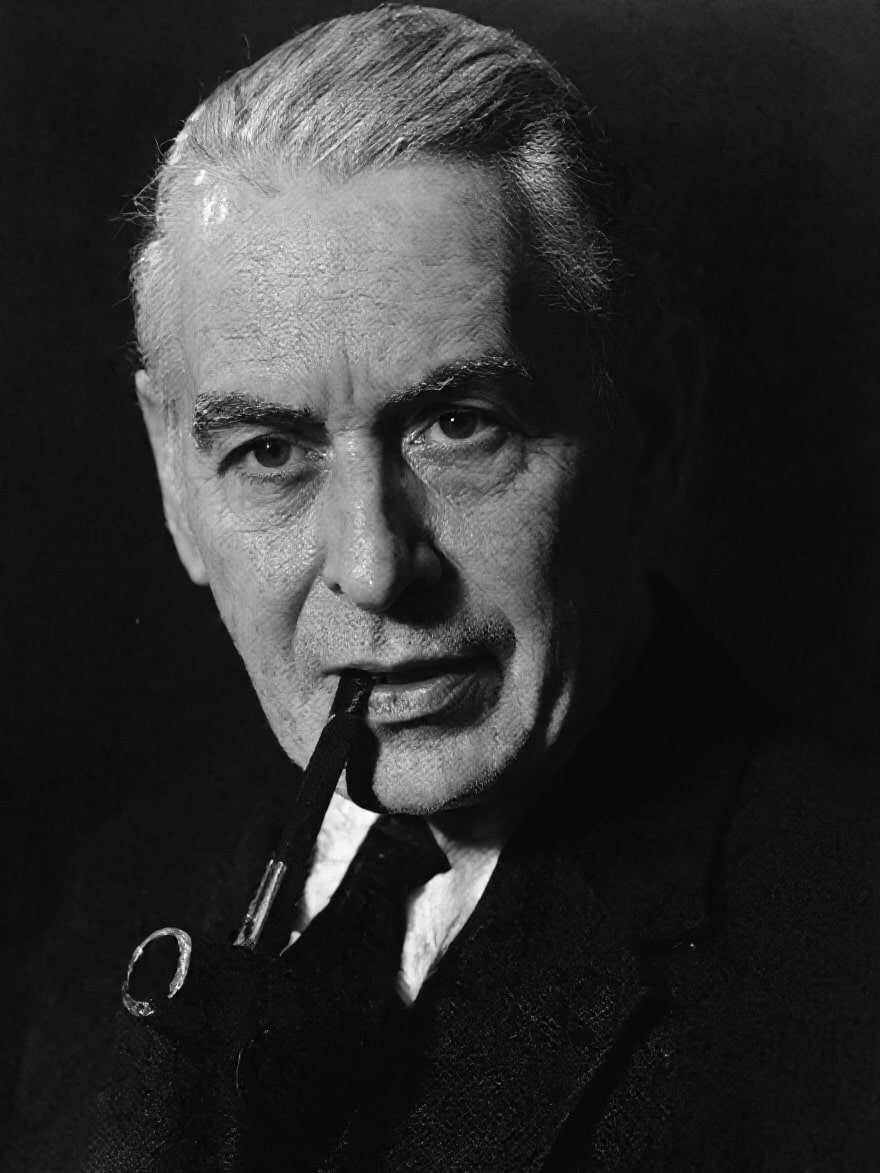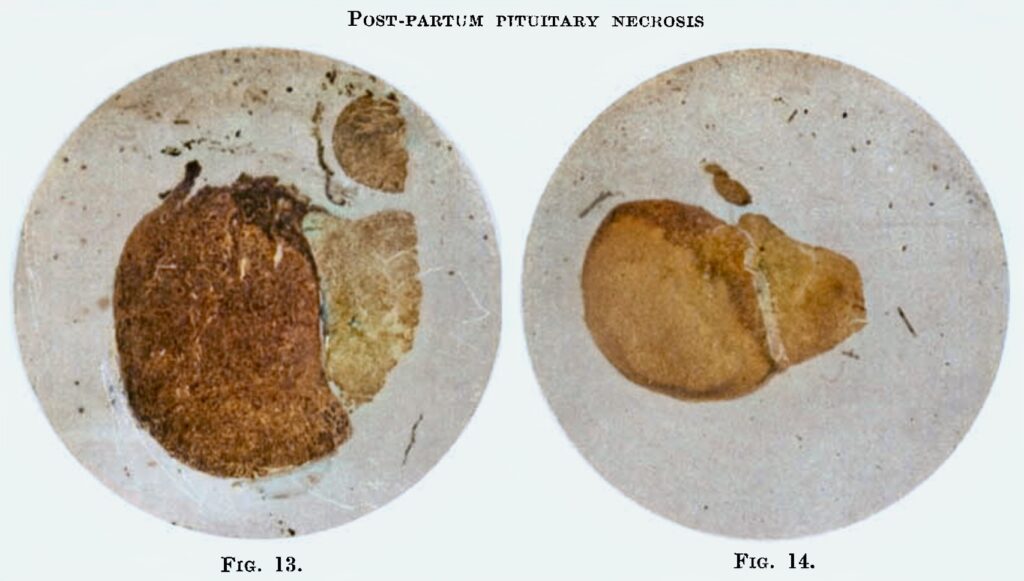Harold Sheehan

Harold Leeming Sheehan (1900-1988) was an English physician and pathologist
Sheehan initiated much experimental work designed to elucidate the pathogenesis of both pituitary necrosis and renal cortical necrosis
Sheehan analysed the effects of obstetrical shock; differentiated fatty liver of delayed chloroform poisoning and primary fatty liver of pregnancy; demonstrated reactivation of latent rheumatic heart disease induced by pregnancy; clarified the effects of eclampsia upon the liver and kidneys; identified the encephalopathy of hyperemesis gravidarum as Wernicke’s disease; recognized the association between concealed accidental haemorrhage and renal cortical necrosis and recognized that obstetrical shock and haemorrhage could induce necrosis of the anterior lobe of the pituitary gland…
Eponymously remembered for his description of Sheehan Syndrome in 1937
Biography
- Born on August 4, 1900 in Carlisle and educated at Carlisle Grammar School
- 1921 – MB ChB, University of Manchester
- 1921-1927 General practice with older brother in the practice of their father Dr Patrick Sheehan
- 1927 – Demonstrator, and later a lecturer, in the department of pathology in the University of Manchester. Working with John Shaw Dunn, whose chief interest was in renal disease, with whom he undertook experimental work on renal function
- 1931 – MD, thesis on the deposition of dyes in the mammalian kidney
- 1932 – MSc, thesis on the renal elimination of injected urea and creatinine
- 1934 – Rockefeller medical fellowship to continue his studies on renal function; department of pharmacology, Johns Hopkins medical school in Baltimore
- 1935-1941 Director of research at the Glasgow Royal Maternity Hospital, quickly becoming an international expert on the pathology of pregnancy.
- 1941-1946 Deputy director of pathology to the allied forces in Italy, with the rank of colonel
- 1965 – Retired from chair of pathology;
- Died on October 25, 1988
Medical Eponyms
Sheehan syndrome (1937)
Postpartum hypopituitarism following ischaemic necrosis of the anterior pituitary gland. Pituitary necrosis occurs secondary to hypophyseal portal vessel thrombosis following significant postpartum haemorrhage, hypovolaemia, and shock.
1937 – Sheehan performed a series autopsies of women who had died in late pregnancy, at delivery, or in the puerperium working as a pathologist at Glasgow Royal Maternity Hospital. Sheehan reported 12 of 76 women had extensive destruction of the anterior pituitary and that the common clinical feature was haemorrhagic shock rather than sepsis. He proposed that pituitary necrosis was due to spasm or thrombosis of the arteries to the pituitary rather than from mycotic emboli.
Sheehan also analysed all the previously reported cases of postpartum pituitary necrosis in the literature to demonstrate obstetric haemorrhage as the probable cause, rather than sepsis. He found that even with scant obstetric details in most reports 6 out of the 10 reports were associated with significant obstetric haemorrhage.


1949 – Sheehan and Vincent Kirwan Summers (1914-1975) published in the Quarterly Journal of Medicine on the syndrome of hypopituitarism. The paper demonstrated that emaciation and premature senility (previously considered to be essential for the diagnosis of pituitary insufficiency), were not features of the syndrome.
This paper, rather than Sheehan’s earlier papers on pituitary necrosis, prompted global acceptance of the term ‘Sheehan syndrome’ to describe the syndrome of postpartum pituitary necrosis
Major Publications
- Dunn JS, Kay WW, Sheehan HL. The elimination of urea by the mammalian kidney. J Physiol. 1931 Dec 17;73(4):371-81.
- Kay WW, Sheehan HL. The renal elimination of injected urea and creatinine. J Physiol. 1933 Oct 25;79(4):359-415
- Sheehan HL, Southworth H. The renal elimination of phenol red. J Physiol. 1934; 82(4): 438-58
- Sheehan HL. Post-partum necrosis of the anterior pituitary. The Journal of Pathology and Bacteriology 1937; 45(1): 189-214
- Sheehan HL. Post-Partum Necrosis of the Anterior Pituitary. Trans Edinb Obstet Soc. 1938;58:13-28.
- Sheehan HL, Murdoch R. Post-partum necrosis of the anterior pituitary: Pathological and clinical aspects. J Obstet Gynaecol Br Emp 1938; 45: 456-472
- Sheehan HL. Simmonds’s disease due to post-partum necrosis of the anterior pituitary. Quarterly Journal of Medicine, Oxford. 1939; 8(4): 277–309
- Shaw Dunn J, Sheehan HL, Mcletchie NGB. Necrosis of islets of langerhans produced experimentally. Lancet 1943; 241(6242): 484-487
- Sheehan HL, Summers VK. The syndrome of hypopituitarism, Quarterly Journal of Medicine, Oxford, 1949; 18(4): 319–378
- Sheehan HL, Moore HC. Renal Cortical Necrosis And The Kidney Of Concealed Accidental Haemorrhage. 1952
- Sheehan HL. Atypical Hypopituitarism. Proc R Soc Med. 1961 Jan;54(1):43-8.
- Sheehan HL. The repair of post-partum necrosis of the anterior lobe of the pituitary gland. Acta Endocrinol (Copenh). 1965 Jan;48:40-60.
- Sheehan HL, Lynch JB. Pathology of toxemia of pregnancy. 1973
- Sheehan HL, Davis JC. Post-partum hypopituitarism. 1982
References
Biography
- Obituary. H L Sheehan. British Medical Journal 1988; 297
- Wilson BA, Willis MS. Sheehan, Harold Leeming (1900–1988). Pioneers in Pathology, 2017: 483–488
- Biography: Harold Leeming Sheehan. Lives of the Fellows of the Royal College of Physicians of London. Munk’s Roll: Volume VIII: 455.
- Bibliography. Sheehan, H. L. (Harold Leeming). WorldCat Identities
Eponymous terms
- Kovács K. Necrosis of anterior pituitary in humans. I. Neuroendocrinology. 1969;4(3):170-99.
- Kovács K. Necrosis of anterior pituitary in humans. II. Neuroendocrinology. 1969;4(4):201-41.
- Gonzalez JG, Elizondo G, Saldivar D, Nanez H, Todd LE, Villarreal JZ. Pituitary gland growth during normal pregnancy: an in vivo study using magnetic resonance imaging. Am J Med. 1988 Aug;85(2):217-20
- Kovacs K. Sheehan syndrome. Lancet. 2003 Feb 8;361(9356):520-2.
- Tessnow AH, Wilson JD. The changing face of Sheehan’s syndrome. Am J Med Sci. 2010; 340(5): 402-6.
- Karaca Z, Laway BA, Dokmetas HS, Atmaca H, Kelestimur F. Sheehan syndrome. Nat Rev Dis Primers. 2016 Dec 22;2:16092
- Schury MP, Adigun R. Sheehan Syndrome. 2021 Sep 8. In: StatPearls [Internet].
Eponym
the person behind the name
Doctor in Australia. Keen interest in internal medicine, medical education, and medical history.
